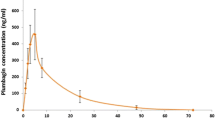Summary
The potential to inhibit drug metabolism of the new antifungal agent terbinafine has been studied using antipyrine (single oral dose of 10 mg/kg) as a probe drug. In a cross-over study in 8 healthy volunteers, antipyrine was administered prior to, during and after 8 days of oral terbinafine 125 mg b.d. Antipyrine, its major metabolites 4-hydroxyantipyrine (4-OH-AP), 3-hydroxymethylantipyrine (3-OH-CH3-AP) and norantipyrine (Nor-AP) were analyzed by specific HPLC assays in multiple plasma and urine samples.
During all three parts of the study, the pharmacokinetics of antipyrine viz. t1/2 (11.7 h), total plasma (38.5 ml·h−1·kg−1) and renal clearance (1.6 ml·h−1·kg−1), and its clearance rates to metabolites (CLM), eg. CLM for 4-OH-AP (12.3 ml·h−1·kg−1), CLM for 3-OH-CH3-AP (4.2 ml·h−1·kg−1) and CLM for Nor-AP (6.7 ml·h−1·kg−1) did not differ from the control values.
Thus, all the cytochrome P-450-dependent isozymes involved in the metabolism of antipyrine and many other drugs should not be affected by therapeutic doses of terbinafine.
Similar content being viewed by others
References
Allen JG, Alderson J, Galloway DB, Hallett C (1987) The effect of midazolam administration on antipyrine pharmacokinetics in humans. Xenobiotica 17: 875–879
Alvares AP, Kappas A, Eiseman JL, Anderson KE, Pantuck CB, Pantuck EJ, Hsiao K-C, Garland WA, Conney AH (1979) Intraindividual variation in drug disposition. Clin Pharmacol Ther 26: 407–419
Brown MW, Maldano AL, Meredith CG, Speeg KV Jr (1985) Effect of ketoconazole on hepatic oxidative drug metabolism. Clin Pharmacol Ther 37: 290–297
Danhof M (1980) Antipyrine metabolite profile as a tool in the assessment of the activity of different drug oxidizing enzymes in man. Dissertation, Faculty of Pharmacy, University of Leiden, The Netherlands
Eichelbaum M, Spannbrucker (1977) Rapid and sensitive method for the determination of antipyrine in biological fluids by high pressure liquid chromatography. J Chromatogr 140: 288–292
Eichelbaum M, Sonntag B, Dengler HJ (1981) HPLC determination of antipyrine metabolites. Pharmacology 23: 192–202
Eichelbaum M, Bertilsson L, Säwe J (1983) Antipyrine metabolism in relation to polymorphic oxidation of sparteine and debrisoquine. Br J Clin Pharmacol 15: 317–321
Ganzinger U, Stutz A, Petranyi G, Stephen A (1986) Allylamines: Topical and oral treatment of dermatomycoses with a new class of antifungal agents: Acta Derm Venerol [Suppl] (Stockh) 121: 155–160
Klotz U, Reimann IW (1984) Drug interactions through binding to cytochrome P-450: The experience with H2-receptor blocking agents. Pharmacol Res 2: 59–62
Klotz U, Arvela P, Pasanen M, Kroemer H, Pelkonen O (1987) Comparative effects of H2-receptor antagonists on drug metabolism in vitro and in vivo. Pharmacol Ther 33: 157–161
Odds FC, Milne LJ, Gentles JC, Ball EH (1980) The activity in vitro and in vivo of a new imidazole antifungal, ketoconazole. J Antimicrob Chemother 6: 97–104
Ohnhaus EE, Brockmeyer N, Dylewicz P, Habicht H (1987) The effect of antipyrine and rifampicin on the metabolism of diazepam. Clin Pharmacol Ther 42: 148–156
Poulsen HE, Loft S (1988) Antipyrine as a model drug to study hepatic drug-metabolizing capacity. J Hepatol 6:374–382
Murray M (1987) Mechanisms of the inhibition of cytochrome P-450-mediated drug oxidation by therapeutic agents. Drug Metab Rev 18: 55–81
Rodrigues AD, Gibson GG, Joannides C, Parke DV (1987) Interactions of imidazole antifungal agents with purified cytochrome P-450 proteins. Biochem Pharmacol 36: 4277–4281
Ryder NS (1985) Specific inhibition of fungal sterol biosynthesis by SF 86-327, a new allylamine antimycotic agent. Antimicrob Agents Chemother 27: 252–256
Schuster I (1985) The interaction of representative members from two classes of antimycotics — the azoles and the allylamines — with cytochromes P-450 in steroidogenic tissues and liver. Xenobiotica 15: 529–546
Vessel ES (1979) The antipyrine test in clinical pharmacology: Conceptions and misconceptions. Clin Pharmacol Ther 26: 275–286
Author information
Authors and Affiliations
Rights and permissions
About this article
Cite this article
Seyffer, R., Eichelbaum, M., Jensen, J.C. et al. Antipyrine metabolism is not affected by terbinafine, a new antifungal agent. Eur J Clin Pharmacol 37, 231–233 (1989). https://doi.org/10.1007/BF00679775
Received:
Accepted:
Issue Date:
DOI: https://doi.org/10.1007/BF00679775




